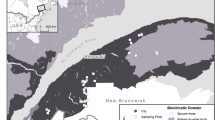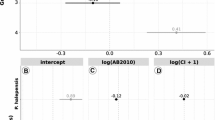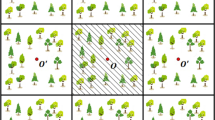Abstract
Determining the competitor selection methods for spatial explicit competition indices is important for individual tree growth modelling and forest management. There is a lack of systematic comparisons on these methods for natural mixed forest, however. In this paper, subplots with the area of 0.0625 ha were randomly sampled from 3 one-hectare remeasured and stem-mapped plots and repeated 200 times for natural spruce-fir-broadleaf mixed forests in northeast China with a bootstrapping method. Totally 600 subplots were used to examined the optimal competitor selection methods. Nine distance-dependent competition indices (CIs) and nine main competitor selection methods were tested by including them in the individual tree basal area growth models. After the analysis of the difference in the performance between partial model (only DBH was included) and full model (both DBH and CIs were included), we found that the difference among the statistically valid methods was weak (the increase in the adjusted coefficient of determination were 0.042 to 2.014%, the mean square errors were 0.060 to 2.851%). According to the magnitude and consistency of the contribution of the selection methods for a CI and the sensitivity to distinguish the competition effects on tree growth among the constituent tree species, we comprehensively concluded that the optimal competitor selection method was dependent on the CI, but the difference among these methods was weak. In addition, the CI from Alemdag (Alemdag IS (1978) Evaluation of some competition indexes for the prediction of diameter increment in planted white spruce. Information Report Forest Management Institute (Canada) No. FMR-X-108.) with the gradually expanding radius of circle method and 8 m radius of influence circle was the best combination which could efficiently detect the difference in competition effects on tree growth among tree species groups.







Similar content being viewed by others
Data availability
The processed data required to reproduce these findings cannot be shared at this time as the data also forms part of an ongoing study.
References
Alemdag IS (1978) Evaluation of some competition indexes for the prediction of diameter increment in planted white spruce. Information Report Forest Management Institute (Canada) No. FMR-X-108.
Arney JD (1973) Tables for quantifying competitive stress on individual trees. Environment Canada, Canadian Forestry Service, Pacific Forest Research Centre, Victoria, B.C., Information Report BC-X-078.
Bauhus J, Puettmann K, Messier C (2009) Silviculture for old-growth attributes. For Ecol Manage 258(4):525–537. https://doi.org/10.1016/j.foreco.2009.01.053
Bella IE (1971) A new competition model for individual trees. For Sci 17(3):364–372. https://doi.org/10.1093/forestscience/17.3.364
Biging GS, Dobbertin M (1995) Evaluation of competition indices in individual tree growth models. For Sci 41(2):360–377. https://doi.org/10.1093/forestscience/41.2.360
Bitterlich W (1952) Die winkelzählprobe. Forstwissenschaftliches Centralblatt 71(7–8):215–225. https://doi.org/10.1007/BF01821439
Bosela M, Tobin B, Šebeň V, Petráš R, Larocque GR (2015) Different mixtures of Norway spruce, silver fir, and European beech modify competitive interactions in central European mature mixed forests. Can J for Res 45(11):1577–1586. https://doi.org/10.1139/cjfr-2015-0219
Boyden S, Binkley D (2016) The effects of soil fertility and scale on competition in ponderosa pine. Eur J Forest Res 135(1):153–160. https://doi.org/10.1007/s10342-015-0926-7
Boyden S, Montgomery R, Reich PB, Palik B (2012) Seeing the forest for the heterogeneous trees: stand-scale resource distributions emerge from tree-scale structure. Ecol Appl 22(5):1578–1588. https://doi.org/10.1890/11-1469.1
HE Burkhart, M Tomé, (2012) Modeling forest trees and stands. Dordrecht, Netherlands https://doi.org/10.1007/978-90-481-3170-9
Canham CD, LePage PT, Coates KD (2004) A neighborhood analysis of canopy tree competition: effects of shading versus crowding. Can J for Res 34(4):778–787. https://doi.org/10.1139/x03-232
Cattaneo N, Bravooviedo A, Bravo F (2018) Analysis of tree interactions in a mixed Mediterranean pine stand using competition indices. Eur J Forest Res 137(1):109–120. https://doi.org/10.1007/s10342-017-1094-8
Contreras MA, Affleck D, Chung W (2011) Evaluating tree competition indices as predictors of basal area increment in western Montana forests. For Ecol Manage 262(11):1939–1949. https://doi.org/10.1016/j.foreco.2011.08.031
Coomes DA, Allen RB (2007) Effects of size, competition and altitude on tree growth. J Ecol 95(5):1084–1097. https://doi.org/10.1111/j.1365-2745.2007.01280.x
Corral Rivas JJ, Álvarez González JG, Aguirre O, Hernández FJ (2005) The effect of competition on individual tree basal area growth in mature stands of Pinus cooperi Blanco in Durango (Mexico). Eur J for Res 124(2):133–142. https://doi.org/10.1007/s10342-005-0061-y
Daniels RF, Burkhart HE, Clason TR (1986) A comparison of competition measures for predicting growth of loblolly pine trees. Canad J for Res 16(6):1230–1237
Das A, Battles J, Stephenson NL, van Mantgem PJ (2011) The contribution of competition to tree mortality in old-growth coniferous forests. For Ecol Manage 261(7):1203–1213
Franklin JF, Shugart HH, Harmon ME (1987) Tree death as an ecological process. Bioscience 37(8):550–556. https://doi.org/10.2307/1310655
DI Gerrard, (1969) Competition quotient: a new measure for the competition affecting individual forest trees. Agricultural Experiment Station, Michigan State University Research Bulletin
Harper JL (1977) Population biology of plants. Academic Press, London
Hegyi F (1974) A simulation model for managing jack pine stands. In: Fried J (ed) Growth models for tree and stand simulations. Royal College of Forestry, Stockholm, pp 74–90
Hui GY, Wang Y, Zhang GQ, Zhao ZH, Bai C, Liu WZ (2018) A novel approach for assessing the neighborhood competition in two different aged forests. For Ecol Manage 422:49–58. https://doi.org/10.1016/j.foreco.2018.03.045
Lee WK, Gadow KV (1997) Iterative Bestimmung von Konkurrenzbaeume in Pinus densiflora Bestaenden (Iterative selection of competitor trees in Pinus densiflora stands). Allgemeine Forstund Jagdzeitung 168(3–4):41–45
Lorimer CG (1983) Tests of age-independent competition indices for individual trees in natural hardwood stands. For Ecol Manage 6(4):343–360. https://doi.org/10.1016/0378-1127(83)90042-7
Lu J (2005) Study on individual tree growth model of natural mixed forest in Changbai Mountain Area. Dissertation, Northeast Forestry University
Luo Y, Chen HY (2011) Competition, species interaction and ageing control tree mortality in boreal forests. J Ecol 99(6):1470–1480. https://doi.org/10.1111/j.1365-2745.2011.01882.x
Kahriman A, Şahin A, Sönmez T, Yavuz M (2018) A novel approach to selecting a competition index: the effect of competition on individual-tree diameter growth of Calabrian pine. Can J for Res 48(10):1217–1226. https://doi.org/10.1139/cjfr-2018-0092
Kuehne C, Weiskittel AR, Waskiewicz J (2019) Comparing performance of contrasting distance-independent and distance-dependent competition metrics in predicting individual tree diameter increment and survival within structurally-heterogeneous, mixed-species forests of Northeastern United States. For Ecol Manage 433:205–216. https://doi.org/10.1016/j.foreco.2018.11.002
Kunstler G, Lavergne S, Courbaud B, Thuiller W, Vieilledent G, Zimmermann NE, Kattge J, Coomes DA (2012) Competitive interactions between forest trees are driven by species’ trait hierarchy, not phylogenetic or functional similarity: implications for forest community assembly. Ecol Lett 15(8):831–840. https://doi.org/10.1111/j.1461-0248.2012.01803.x
Maleki K, Kiviste A, Korjus H (2015) Analysis of individual tree competition on diameter growth of silver birch in Estonia. For Syst 24(2):8. https://doi.org/10.5424/fs/2015242-05742
Martin GL, Ek AR (1984) A comparison of competition measures and growth models for predicting plantation red pine diameter and height growth. For Sci 30(3):731–743. https://doi.org/10.1093/forestscience/30.3.731
Mongus D, Vilhar U, Skudnik M, Žalik B, Jesenko D (2018) Predictive analytics of tree growth based on complex networks of tree competition. For Ecol Manage 425:164–176. https://doi.org/10.1016/j.foreco.2018.05.039
Newnham RM (1966) Stand structure and diameter growth of individual trees in a young red pine stand. Department of Forestry.
Ochal W, Socha J, Pierzchalski M (2017) The effect of the calculation method, plot size, and stand density on the accuracy of top height estimation in Norway spruce stands. iForest 10(2):498–505. https://doi.org/10.3832/ifor2108-010
Okabe A, Boots B, Sugihara K, Chiu SN (2000) Spatial tessellations: concepts and applications of voronoi diagrams. Coll Math J 26(1):79. https://doi.org/10.2307/2687299
Pommerening A, Stoyan D (2006) Edge-correction needs in estimating indices of spatial forest structure. Can J for Res 36(7):1723–1739. https://doi.org/10.1139/x06-060
Pretzsch H (1995) On the effect of the spatial-distribution of trees on the stand growth. Allgemeine Forstund Jagdzeitung.
Pretzsch H (2009) Forest dynamics, Growth and Yield. Verlag Berlin Heidelberg, Germany. https://doi.org/10.1007/978-3-540-88307-4
Quiñonez-Barraza G, Zhao DH, Héctor M, Corral-Rivas JJ (2018) Considering neighborhood effects improves individual dbh growth models for natural mixed-species forests in Mexico. Ann for Sci 75(3):78. https://doi.org/10.1007/s13595-018-0762-2
R Core Team (2016) R: A language and environment for statistical computing. R foundation for statistical computing, Vienna. http://www.R-project.org (accessed 01.03.2016)
Richards M, McDonald AJS, Aitkenhead MJ (2008) Optimisation of competition indices using simulated annealing and artificial neural networks. Ecol Model 214(2–4):375–384. https://doi.org/10.1016/j.ecolmodel.2008.03.008
Schröder J, Gadow KV (1999) Testing a new competition index for Maritime pine in northwestern Spain. Can J for Res 29(2):280–283. https://doi.org/10.1139/x98-199
Sharma RP, Brunner A, Eid T (2012) Site index prediction from site and climate variables for Norway spruce and Scots pine in Norway. Scand J for Res 27:619–636. https://doi.org/10.1080/02827581.2012.685749
Sharma PR, Vacek Z, Vacek S, Kučera M (2019) A nonlinear mixed-effects height-to-diameter ratio model for several tree species based on czech national forest inventory data. Forests 10(70):1–31. https://doi.org/10.3390/f10010070
Simard SW, Sachs DL (2004) Assessment of inter-specific competition using relative height and distance indices in an age sequence of several interior cedar hemlock forests in British Columbia. Can J for Res 34(6):1228–1240. https://doi.org/10.1139/x04-008
Sims A, Kiviste A, Hordo M, Laarmann D, Gadow KV (2009) Estimating tree survival: a study based on the Estonian forest research plots network. Ann Bot Fenn 46(4):336–352. https://doi.org/10.5735/085.046.0409
Staebler GR (1951) Growth and spacing in an even-aged stand of Douglas fir. Dissertation, University of Michigan
Sun O (1977) Growth model for simulation of a Calabrian pine (Pinus brutia Ten.) tree. Forestry Research Institute. Technical Bulletin Series.
Szwagrzyk J, Szewczyk J, Maciejewski Z (2012) Shade-tolerant tree species from temperate forests differ in their competitive abilities: a case study from Roztocze, south-eastern Poland. For Ecol Manage 282:28–35. https://doi.org/10.1016/j.foreco.2012.06.031
Taboada MÁ, Anta MB, Varela JG, González JÁ (2003) Influencia de la competencia en el crecimiento en sección en Pinus radiata D Don. Investigación Agraria. Sistemas y Recursos Forestales 12(2):25–35
Tenzin J, Tenzin K, Hasenauer H (2017) Individual tree basal area increment models for broadleaved forests in Bhutan. Forestry 90:367–380. https://doi.org/10.1093/forestry/cpw065
Tomé M, Burkhart HE (1989) Distance-dependent competition measures for predicting growth of individual trees. For Sci 35(3):816–831. https://doi.org/10.1093/forestscience/35.3.816
von Gadow K, Hui GY (2002) Characterizing forest spatial structure and diversity. In: Björk L (ed) Sustainable forestry in temperate regions. SUFOR University of Lund, Lund, Sweden, pp 20–30
von Oheimb G, Lang AC, Bruelheide H, Forrester DI, Wäsche I, Yu M, Härdtle W (2011) Individual-tree radial growth in a subtropical broad-leaved forest: the role of local neighbourhood competition. For Ecol Manage 261(3):499–507. https://doi.org/10.1016/j.foreco.2010.10.035
Weigelt A, Jolliffe P (2003) Indices of plant competition. J Ecol 91(5):707–720. https://doi.org/10.1046/j.1365-2745.2003.00805.x
Wimberly MC, Bare BB (1996) Distance-dependent and distance-independent models of Douglas-fir and western hemlock basal area growth following silvicultural treatment. For Ecol Manage 89(1–3):1–11. https://doi.org/10.1016/S0378-1127(96)03870-4
Wykoff WR, Crookston NL, Stage AR (1982) User's guide to the stand prognosis model. USDA Forest Service, Intermountain forest and range experiment station, General Technical Report INT-133. Ogden, UT.
Zhao DH, Borders B, Wilson M (2004) Individual-tree diameter growth and mortality models for bottomland mixed-species hardwood stands in the lower Mississippi alluvial valley. For Ecol Manage 199(2–3):307–322. https://doi.org/10.1016/j.foreco.2004.05.043
Acknowledgements
We would like to thank all people contributing to sample plot survey for this study. We wish to express our appreciation to the editor and two anonymous reviewers for your in-depth comments, suggestions, and corrections, which have greatly improved the manuscript.
Funding
This research was funded by National Natural Science Foundation of China (Grant No. 31870623) and National Key R&D Program of China (Grant No. 2017YFC0504101).
Author information
Authors and Affiliations
Contributions
MZ collected the field data, performed data analysis, and wrote the paper; XL supervised and coordinated the research project, designed and installed the experiment, took some measurements, and revised the paper; JL and WG designed and installed the experiment, and took some measurements and collected the field data; HZ supervised and coordinated the research project. All authors have read and agreed to the published version of the manuscript.
Corresponding author
Ethics declarations
Conflicts of Interest
The authors declare no conflict of interest.
Code availability
The R code generated or used during the study are available from the corresponding author by request.
Additional information
Communicated by Thomas Seifert.
Publisher's Note
Springer Nature remains neutral with regard to jurisdictional claims in published maps and institutional affiliations.
Appendices
Appendix 1
See Table 11.
Appendix 2
See Table 12.
Appendix 3
See Table 13.
Appendix 4
See Table 14.
Appendix 5
See Table 15.
Rights and permissions
About this article
Cite this article
Zhou, M., Lei, X., Lu, J. et al. Comparisons of competitor selection approaches for spatially explicit competition indices of natural spruce-fir-broadleaf mixed forests. Eur J Forest Res 141, 177–211 (2022). https://doi.org/10.1007/s10342-021-01430-8
Received:
Revised:
Accepted:
Published:
Issue Date:
DOI: https://doi.org/10.1007/s10342-021-01430-8




